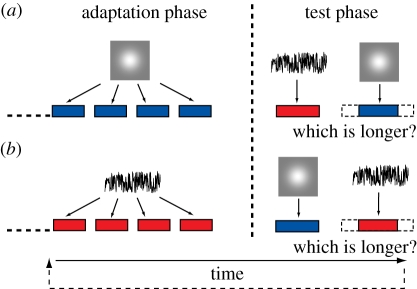Figure 1.
A schematic showing the paradigm used for the main adaptation experiments (figures 2–4; electronic supplementary material, figures S1, S2 and S5). Observers adapt to either (a) visual Gaussian blobs (in blue) or (b) bursts of auditory white noise (in red). The adaptation phase consists of 100 stimuli of identical duration (not shown) while the test phase consists of a reference stimulus from the opposing modality followed by a test stimulus (from the modality matching the adapting stimuli) of variable duration. In this example, adaptation stimuli are of a relatively short duration (e.g. 160 ms) relative to moderate duration reference (e.g. 320 ms). The last four adaptation stimuli are repeated between test phases to form a ‘top-up’ phase. For simplicity, the ISI is shown here as fixed, whereas in reality it varied randomly (see §2 for details).

